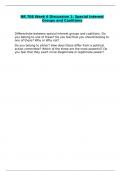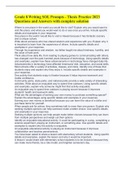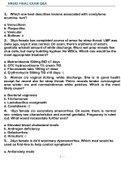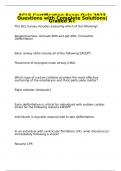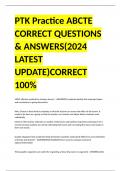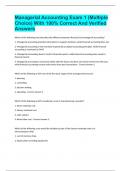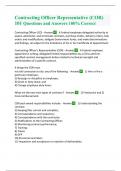Articles Inclusion criteria (number of RQ and Population/ Findings/ Justification
studies) or Method Hypotheses Context Conclusions
1.Junoven Info about it under questions
& Graham
(2013): The
power of
bullies and
the Plight
of victims -
monograph
2.Vreeman Inclusion: Goal of study→review Primarily performed in Overall Conclusions: systematic review,
(2007): A - studies, 1966 - 2004: 26 studies evaluated school-based Europe and the US, Primary >Some of the anti bullying interventions actually qualitative
systematic (described in population cell) interventions to reduce or and secondary school decrease bullying, while others have no effect or more subjective
review of only based on their
> Study describes an prevent bullying with the children→may limit the even seem to increase the amount of bullying
school-bas conclusions
ed experimental intervention with goal of determining whether generalizability > Curriculum changes and interventions providing ,so less strong than
interventio control and intervention groups, these interventions worked >Some interventions with training in social skills seldom improved bullying, meta-analysis
ns to includes follow ups with positive results (mentoring, sometimes increased bullying, results point to the >Only English
prevent measured outcomes increased social workers by systemic nature of bullying and supports the theory language studies
bullying > intervention is school based >Results may be
2.5 workers, and social skills of bullying as a sociocultural phenomenon
systematic and designed to reduce or overestimated
prevent bullying groups for younger children) Thus intervention on 1 layer is not effective
review because schools,
> We did not exclude studies were only studied on a >whole-school interventions→more effective→
not students, were
based on similarities between single occasion→limits their Shows that bullying is sociocultural randomized, leading
treatment groups, study power, generalizability phenomenon. Implementation varies and is to potential errors.
retention rates, or program important, School’s degree of involvement >Ignoring intraclass
intensity because these factors 26 studies: varied in directly related to positive effects of correlation can
intervention type, study intervention. increase false
are not clearly linked to how
population, study design, >Well-planned interventions; chance of success positives, yet many
strong the treatment effects are.
1
, Exclusion: articles that reported and outcome measures is greater if the intervention incorporates a studies still found
identical outcomes measured >interventions divided into whole-school approach involving multiple no treatment
over the same period on the 5 categories: 1)curriculum disciplines and the whole school community effects.
>Different outcome
same population were excluded interventions, 2) >WSI works less on younger children (they need
measures can make
multidisciplinary or to assert dominance) it harder to
whole-school interventions, >School staff’s commitment to implementing accurately assess
3)targeted social and the intervention also may play a crucial role in intervention effects.
behavioral skills groups, 4) its success
mentoring, and 5) increased -> Olweus program succeeded in one study and
social work support in another not, might be due to
implementation, staff commitment. Also might
be not generalieazble beyond Norway. Doesnt
give instructions how to implement it in another
school..
>Social skills training worked better on younger
children.
3.Jimenez-B Meta-analytic investigation on Population: children and Conclusions: Quantitative meta
arbero et Inclusion: the effectiveness of adolescents aged from 7 to !!!There is some evidence of the effectiveness of -analysis - more
al. (2015): >Goal should be the evaluation school-based programs to 16 years of Primary and interventions aimed at preventing school violence objective.
of the effectiveness of an and bullying, reducing the frequency of >14 studies (most
prevent or reduce bullying or Secondary schools
Effectivenes intervention program to prevent victimization and bullying, and improving studies from 2013:
violence or bullying in the school violence at school using Total size of the sample of the attitudes toward school violence. only included high
s of
setting random meta-analysis included >Outcome measures: frequency of bullying quality→ higher
anti-bullyin
>Assessed interventions had to clinical trials (RCT) 30,934 pp→16,243 pp /school violence and frequency of school quality of analysis,
g school target the study population victimization→ both had modest reductions but disadvantage
formed the IG and 14,691 pp
programs – directly (students of Primary or > Both outcome measures should be considered that it reduces the
comprised the CG
a Secondary schools), not teachers considering heterogeneity of effect sizes among number of studies
>Programs were aimed at the
meta-analys or parents studies → Could be due to possible publication for each
prevention or reduction of
is >Should use an experimental bias (funnel effect). comparison.
2
,design violence or intimidation at (> More studies
>Had to provide the necessary school, but outcome *Heterogeneity among studies" means there would have
statistical info from the control measures varied among the were differences in the results and methods of provided more
group (CG) and the intervention the studies, leading to variability in the effect power and would
different studies
group (IG), at least at posttest sizes. explain
(means and SD) > 14 studies: most from 2013 heterogeneity)
>Should be published between >For cases with significant Results:
2000 and 2015→ 14 studies. heterogeneity→conducted >Bullying or school violence frequency; including >Precaution in the
an analysis of subgroups direct (physical or verbal) and indirect aggression: interpretation of
according to moderating ->It was reduced discreetly (?) results because
variables: >Higher mean effect size for interventions lasting most of the mean
less <1 year and those targeting children of age ≤ effect sizes are too
1) Studies published
10 years weak to be
2000-2007 or after 2007 > Greater Heterogeneity in effect sizes among the considered
2) Sample sized: >400 or <400 studies compared significant (also
3) features of the occurs with most of
intervention (interventions > School victimization frequency (direct or the individual effect
based on a global or indirect aggression) sizes)
multidisciplinary approach vs. >Intervention had reduced effects on the > Evaluated
frequency of victimization by bullying, but Publication biases
interventions based on more
heterogeneity among the studies was observed
specific models) >Possible publication bias.
4) duration of the > Moderating effects: better results in studies
intervention(continuous after 2007 and those with interventions that
interventions or with a lasted less than one school year
duration equal to or greater > Homogeneity among the studies on
interventions targeting children aged ≤10 years,
than a school course,
those that did not use global or multidisciplinary
integrated in the study plan approaches, those that used smaller sample sizes,
vs. brief interventions or less and those studies that were conducted in or
than a school course) before 2007
3
, > Favorable attitudes toward bullying or school
violence
>Moderate significant beneficial effects.
>homogeneity among the studies, but interpret
with caution since based on 3 studies only, so it
was not possible to evaluate for publication bias
→ Suggests that attitudes toward violence gain
the most benefit from such programs
>Attitudes against bullying or school violence →
included 4 studies
>Revealed homogenous results→but mean effect
size of the intervention was small and insignificant
(but positive effect size)
> School climate (students' perceptions of trust,
cooperation, and willingness to help) →included 3
studies
>Studies were homogenous→but meta-analysis
hardly showed any significant differences after
the intervention, small reductions of the values
of this measure
- There are no meta-analytic studies that
have considered this variable→complex
to assess such a measure, but figure of
funnel-plot shows possible publication
bias
>Publication bias in Frequency of victimization
and School Climate.
4.Van der > Compared Kiva intervention >Investigates the Kiva programe in Dutch Results: Limitations
4


